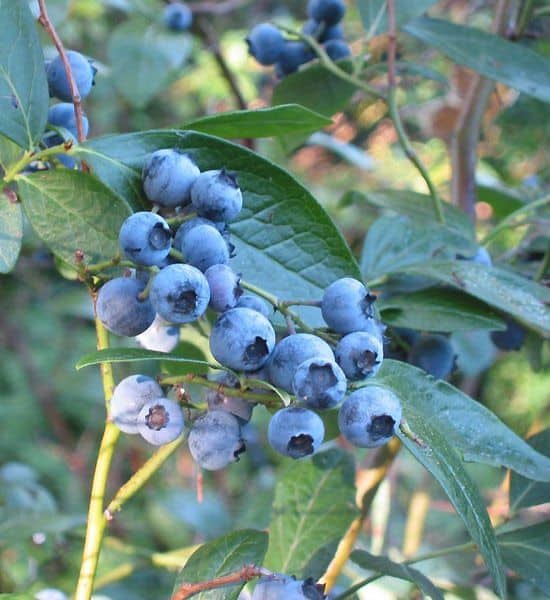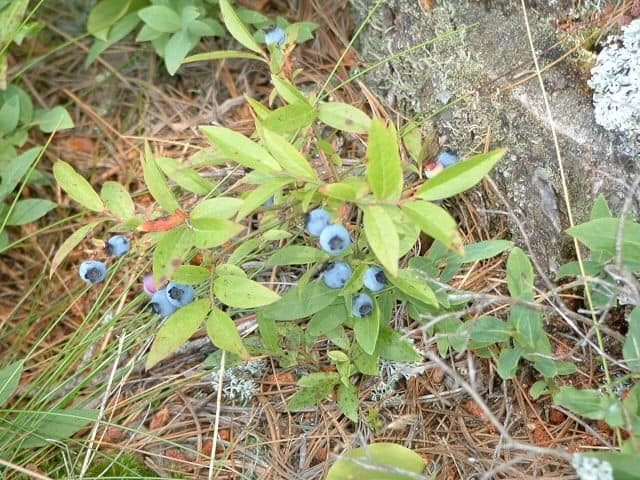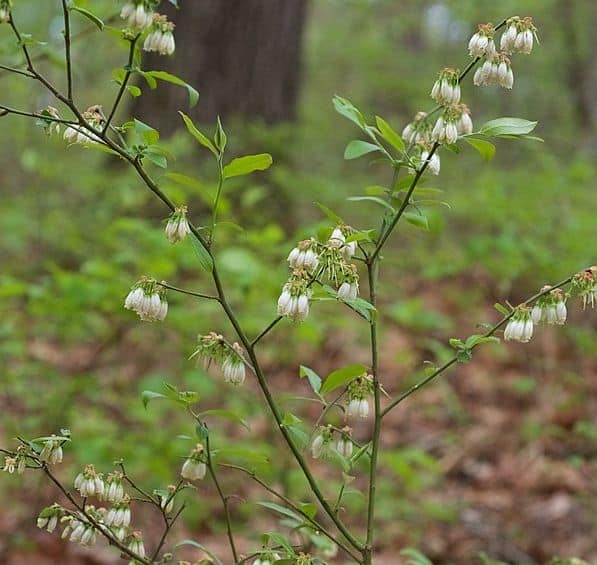Blueberries are easy-to-grow fruits that not only are incredibly productive, but are beautiful to look at, too. In the spring, your plants will flower, producing flowers that are pink or white and shaped like tiny urns.
In the summer, you will of course see berries that are green, then red or pink, and finally blue, and in the fall, the leaves of these bushes will turn a vibrant crimson.

Even in the winter blueberry bushes are beautiful to look at, with branches and twigs that look to be a bright red in color.
Blueberries are incredibly healthy for you, too. Loaded with fiber and antioxidants, these plants produce fruits that are considered superfoods and should be part of any healthy diet.
Fortunately, growing your own blueberries is easy, and it doesn’t take a lot of background knowledge or experience to do. These plants more or less take care of themselves once you get them in the ground.
Here’s what you need to know to grow a bountiful crop of blueberries that you can eat fresh, freeze, can, or make into your favorite baked goods (the best option, in my opinion!). I’m not sure if there’s anything I enjoy more than a fresh pan of blueberry muffins!
Types of Blueberries
There are three main species of blueberries you can choose from when starting your berry garden.

The most common variety is the highbush blueberry (Vaccinium corymbosum). This plant grows best in zone 4 to 7. As a shrubby plant, it can grow up to 12 feet tall, and is found in eastern states, usually along the coast. Highbush blueberries are known for producing lots of large, juicy berries.

Another cold-hardy variety of blueberry is the lowbush blueberry (Vaccinium angustifolium). These plants grow best in zones 3 to 7, and grow even taller than highbush varieties – up to 18 inches tall! They often grow low to the ground, however, so height isn’t automatically a given. These plants produce smaller berries than highbush plants, but they’re often much sweeter.
If you want a plant that has all the best qualities of highbush and lowbush blueberries combined, you may want to grow mid-high hybrids.
These plants grow up to three feet tall and have all the flavor and cold hardiness of lowbush plants but with the larger berry size you’ll find on highbush plants.

One final option for you to consider is the rabbiteye blueberry (Vaccinium virgatum). This plant is native to the southeast portions of the United States, and can grow in warm areas but only as cold as zone 7 (no colder).
It is a plant that is both drought- and heat-resistant and grows up to 20 feet tall, producing bright pink berries that become blue when ripe.
Some blueberry plants require cross-pollination, while others are self-fertile – be sure to check what kind yours is before you buy to make sure you have the right conditions. If you purchase a cross-pollinating plant, you’ll need to buy at least two plants.
I always recommend planting more than one cultivar, too. That way, you’ll have plenty of options and different types of blueberries to choose from. It will extend your harvest, and can also ensure pollination.
Remember, not all blueberries flower at the same time – some flower earlier in the spring than others. This can affect your pollination.
To decide which blueberry variety is right for you, consider how you plan to use the berries. Want to eat fresh blueberries? Go with a cultivar that produces larger berries. If you’d rather use your berries for cooking or baking, choose smaller berries.
The average blueberry plant, once established, will yield up to 20 pounds of fruit each year (but it won’t always produce this much). Keep in mind that it can take a plant at least six years to become fully productive, so you’ll need to exercise some patience.
Growing Conditions for Blueberries
Blueberries grow best in places where summers stay cool and the soil is acidic. However, don’t fret if you live in a warmer climate – there are varieties that can thrive in warmer, dryer areas, too.
These long-lived plants are best grown in a spot where they can grow without disturbance for a decade or more. That’s why, when you plant your blueberry plants, you’ll want to make sure it’s a location that you won’t mind having the plants for the long term.
Blueberries grow best when planted in full sun. Although they can tolerate some shade, you may find that your yields are poor. They need acidic soil, as mentioned, along with soil that is rich in organic matter (like compost).
Make sure the soil is well-draining before you plant, as blueberries aren’t crazy about having waterlogged feet.
Test your soil pH before you plant and add sulfur, if necessary, to increase the acidity of your soil. You could also just add some peat moss or compost, which will have the added benefit of improving your drainage and soil structure.
Keep in mind that blueberries don’t grow as well in heavy clay soil! You may need to add a bit of sand.
Planting Blueberries: Bare-Root and Container-Grown
You can plant blueberries either as bare-root, or container-grown plants. Although bare roots are cheaper, it’s important to note that containers establish themselves more quickly.
Container-grown blueberries are a bit more expensive than bare-root options, but often, this is worth it because the plants will grow more voraciously. If you decide to go with containers, choose plants that are certified disease-free and about two or three years old.
For both bare-root and container-grown blueberry bush planting, you will need to adhere to proper spacing requirements. How much space you provide your blueberry bushes will depend on the variety you decide to grow.
Container-grown blueberries are a bit more expensive than bare-root options, but often, this is worth it because the plants will grow more voraciously. If you decide to go with containers, choose plants that are certified disease-free and about two or three years old.
Highbush blueberries should be grown six feet apart, while rabbit eyes need a bit more space – up to eight feet. Lowbush blueberries can be spaced two feet apart, as can mid-high blueberries.
Both container-grown and bare-root blueberries can be planted in the fall or in the spring, but avoid planting when the ground is still wet and/or frozen.
The planting guidelines and recommendations are the same for both bare-root and container-grown plants.
Start by choosing a location that is sheltered, ideally one that is out of a strong wind. If you can’t amend your soil to provide the proper acidity, you may want to consider planting in a raised bed.
This is my favorite way to plant blueberries, actually, since that way I don’t have to worry about accidentally disturbing the plants that I’ve already put in the ground!
Start by preparing a hoel that is half as deep as the root ball of your transplant and twice as wide. Water it so it is evenly moist, but not soggy. Add a bit of compost or bone meal to the soil at the bottom of the hole.
If the roots of your plant are entwined together, massage them gently to loosen and separate them out. Then, put the plant in the hole.
Make sure the soil around the crown is level with the surrounding ground. Firm gently, making sure there are no air pockets.
Then, dig a shallow basin around your plant. This will help hold water when you irrigate your blueberries. It should be dug about one photo from the stem on all sides.
Water deeply and feel free to apply a bit more fertilizer (compost tea is a good choice). After planting, you may want to add about three inches of mulch to the soil. This will keep your soil moist and help prevent weeds.
It can also protect the roots of your blueberry plants from harsh freezes, which is necessary if you are growing in an area that experiences major temperature fluctuations during the winter months in particular.
Caring for Blueberries
Weeding
Blueberry roots are quite shallow, which means it can be hard not to disrupt them when you are weeding. Therefore, it is much easier to prevent weeds from appearing than it is to attempt to pull them.
Apply a thick layer of mulch around your plants to repress weeds and retain soil moisture. Do this once or twice per year. Organic mulch is best, as it will break down around the blueberry roots and support them as they grow.
Depending On the type of blueberry you grow, you might need to protect an early-flowering type with a floating row cover. This will guard it from the frost.
Watering
Blueberries like to be kept in soil that is constantly and evenly moist. The better the watering regimen, the larger and sweeter the berries will be. You will want to provide about an inch of water each week if this is now supplied via regular rainfall.
Pruning
You don’t need to do much to prune or train your blueberry bush. If you are growing a highbush cultivar, just prune it into an upright form. If you have a lowbush variety, just remove old-growth as needed.
Any kind of blueberry bush also lends itself well to a bit of light pruning as berries and flowers develop. Remove both during the first year, even though it can be hard to convince yourself to remove the little fruits!
Sacrificing your fruit the first year will enable the plant to focus its energy on establishing strong roots.
You can also prune to remove damaged, dead, or dying wood. You will be the most successful if you prune in the spring or winter.
Remove any damaged wood so that sunlight can get to the interior growth of the blueberry bush – you can also remove crowded older shoots.
Springtime is also a great time to propagate new blueberry bushes. You can do this by taking a hardwood or softwood cutting, but lowbush blueberries should only be divided when they are dormant (first thing in the spring or late in the winter, before they’ve started actively growing).
Fertilizing
You can fertilize your blueberries once or twice a year. Using aged compost or some other organic mixture will be best, as this will provide a balanced dose of nutrients. However, you should avoid fertilizer that contains calcium or lime, like a tomato fertilizer.
You also need to avoid providing too much nitrogen, as this can cause the plants to put on lots of greenery at the expense of fruits.
Do not supply more than ¼ lb of nitrogen each year.
Pests and Diseases
Unfortunately, there are several creatures that enjoy munching on blueberries just as much as you do!
You can keep birds away from your plants by placing netting over fruit-bearing branches. This will also deter rodents and squirrels. Rabbits frequently snack on blueberries, too – you can prevent them by sprinkling a bit of bonemeal on the plants.
When it comes to pests, however, you will need to set pest-specific traps that target the problematic species.
Blueberry maggots are the most common, and will tunnel into your berries, destroying them before they are even ripe and ready to harvest. You can set traps around your bushes before they start to ripen.
Botha aphids and scale can be prevented by applying dormant oil each winter.
There are a couple of diseases to which blueberries are prone, too. Blueberries can crack and develop canker, but you can prevent this by planting crack-resistant varieties, and pruning your bushes religiously so that only healthy growth remains on the plant.
Another common blueberry disease is mummy berry disease. Keep the mulch around your plants fluffed and airy, and remove loose mulch come wintertime. This disease is related to a fungal growth, and it can cause your berries to turn white and fall from the plant.
Companion Planting
There are several plants that make good companions for blueberries. These include radishes, peppers, endive, parsley, and potatoes.
Not only will planting these species together help spruce up your garden and make it look more colorful and attractive, but it can also help to repel pests and certain diseases.
Growing Blueberries in Containers
Believe it or not, you can also grow your own blueberries in containers! To do this, start with the appropriate variety – most people go with mid-high blueberries, as they don’t reach an overwhelming size that will be difficult for you to manage in a container.
Choose a container that is at least five gallons (or 12-14 inches in diameter). Fill the container with an acid potting mix with at least 50% peat moss or some other semi-acidic soil amendment.
You can start a blueberry plant in a container at any time throughout the growing season, but I always recommend spring, as this will help your blueberries get off to a good start. If you are repotting a plant, try to avoid doing so in very hot or dry weather.
After planting your blueberries, use a fertilizer, keeping in mind that container-grown plants are more likely to leach nutrients and water more quickly than those grown directly in the ground.
Feel free to mulch your container-grown blueberries. That way, you don’t have to worry about nutrients and water leaching out quite as quickly. Weeds should be less of a concern in a container, but mulch can help with that, too.
Do not let your container-grown blueberries dry out – at the same time, don’t let the container sit in water. You may want to put the blueberries in a bit of shade during hot weather.
Harvesting Blueberries
Again, you will need to be patient as you are waiting for your blueberry bushes to establish themselves! They will only start producing fruit in the second or third year (sometimes as late as the fourth).
Blueberries take a long time to ripen – usually, a period of up to seven weeks for the entire plant to finish ripening. You won’t be able to harvest all at once, either, as not all berries on a given cluster will ripen at the same time.
Only harvest berries that are blue and sweet – berries that aren’t blue will taste sour. A good way of telling whether berries are ready for harvest is to gently budget the plant. Ripe berries will fall right off.
Again, don’t harvest under-ripe berries assuming that they will ripen indoors. They can only ripen on the plant.
After pulling berries from the plant, bring them inside and wash them. They are best eaten right away, but can also be stored in the refrigerator for up to two weeks.
Preserving and Using Blueberries
If you don’t know what to do with your sudden influx of blueberries, don’t worry – there are plenty of ways you can make the most of your harvest so they don’t go to waste!
When it comes to cooking with blueberries, your options are unlimited. There are all kinds of recipes you can make, including blueberry jams, syrups, jellies, pies, quickbreads, and muffins. Use them right away or freeze them ahead of time to use them later.
You can also can your blueberries. You may need to add a bit of apple cider vinegar or other preservatives if you plan on using a water bath canner.
Some people even dehydrate their blueberries! This isn’t my favorite way of eating blueberries, but it is an option if you like to have dried fruit to snack on.
Ultimately, knowing how to plant, grow, and harvest blueberries is a skill that any homesteader should have. These plants will produce tons of fruit for many years for you, making them one of the best on-farm fruits you can grow!


Rebekah is a full-time homesteader. On her 22 acres, she raises chickens, sheep, and bees, not to mention she grows a wide variety of veggies. She has a huge greenhouse and does lots of DIY projects with her husband in her ever-growing homesteading endeavor. Learn more about Rebekah here.
